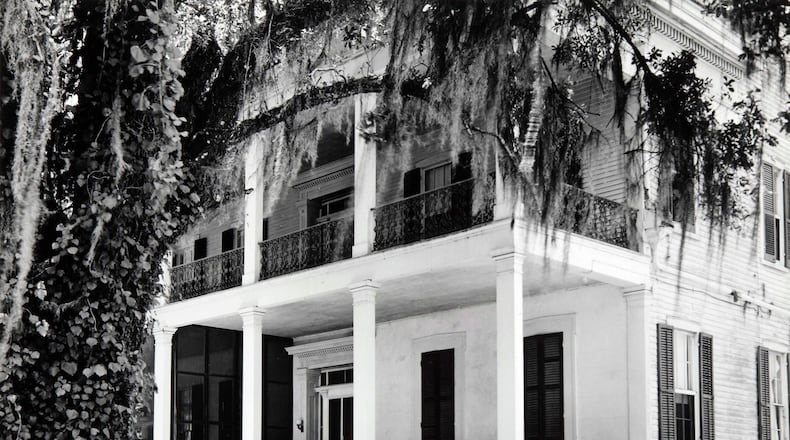The South has turned out an array of photographic heavyweights: William Christenberry, Sally Mann, William Eggleston, many of whom traffic in the South’s revered storytelling skill set.
But the Louisiana-bred, self-taught photographer Clarence John Laughlin (1905-1985) was a man apart, who struggled for recognition in his own time. The solo exhibition at the High Museum of Art “Strange Light: The Photography of Clarence John Laughlin” aims to rekindle interest in this lesser-known photographer, often by juxtaposing his work with his photographic contemporaries, and, less successfully, at other times by teasing out surrealist strains in photographers throughout the ages—Ilse Bing, Jerry Uelsmann, Kenji Nakahashi, Jeff Wall—who tinkered with the same experimentalism and mystical dimensions Laughlin tapped into. Laughlin was an odd duck, more interested in experimentation, allegory and hyperbole when the more fashionable photographic trends were for realism and social documentary as practiced by Laughlin contemporaries such as Minor White, Wynn Bullock and Edward Weston.
Laughlin’s work from 1935 to 1965 certainly trades in some familiar Southern tropes. He had a serious thing for the decrepit beauty of the Spanish moss-draped trees and the antebellum plantation homes that he documented in his book “Ghosts Along the Mississippi.”
Those white-columned mansions framed under petulant skies seem to inhale and exhale, living projections of the Southerners who had occupied them. His images of architecture are genuinely striking: the spooky, theremin-quivering answer to Bernd and Hilla Becher's ice cold architecture. A photograph featured on the cover of a 1983 issue of the Atlanta-based art publication "Art Papers" of a grand staircase glimpsed from below, coiling into the distance like a nautilus shell perfectly encapsulates the anthropomorphic moodiness of his best work.
MORE THINGS TO DO:
-Dave Chappelle returns to Tabernacle June 13-16
-Review: Atlanta's Horizon Theatre serves up topical comedy 'Cake'
Southern gothic themes of death and dying crop up countless times, especially in Laughlin’s gloomy cemetery shots like “The Unending Stream” (1941) of a picture frame filled with graves and statuary. In many ways, Laughlin seemed a progenitor of a photographer like Sally Mann’s evocation of the South as a haunted place, riddled by the ghosts of the past, even while Laughlin ladled out the melodrama in heaping helpings. There is an undeniable element of theatricality, even camp, to his photographs that can conjure up the hyperbolic rhythm of early silent film. He dressed his female models like black-clad crones and shot them posing like Conrad Veidt in “The Cabinet of Dr. Caligari” as graphic specters.
Women seemed a particularly malleable putty for Laughlin. His female models playacted as allegorical spooks and harbingers of mortality in “Water Witch” (1939) and “A Figment of Desire: Woman as a Sex Object” (1941)—empty vessels to fill up with his strange mix of romanticism and morbidity. Laughlin certainly wasn’t the only male photographer to use women to act out his artistic ideas. But his work is a depressing reminder of an age when such gestures were unquestioned and presumed to just be the nature of things: men active, women passive. Though wall text calls Laughlin out for his ham-fisted tendency to depict the old South in idealistic terms, it does no such excavation of his weird approach to women who look like inert funeral statuary in his images, camping around cemeteries in black lace and dramatic gestures in images like “The Bat” (1940).
I can’t say that “Strange Light” entirely sold me on Laughlin’s appeal. He had a maudlin streak a mile long and his view of women was problematic, to say the least. His adventurous experimentation when it came to double exposure, for instance, was admirable and can look shockingly ahead of its time, even if the results can sometimes suggest the trippy, mystical gloominess of vintage hard rock album cover art. If melodrama of the highest order is your jam, Laughlin may be just the guy to guitar solo his way into your heart.
ART REVIEW
“Strange Light: The Photography of Clarence John Laughlin”
Through November 10, 2019. 10 a.m.-5 p.m. Tuesdays-Thursdays and Saturdays; 10 a.m.-9 p.m. Fridays; noon-5 p.m. Sundays. $14.50, ages 6 and above; free for children 5 and younger and members. High Museum of Art, 1280 Peachtree St. NE, Atlanta. 404-733-4444, high.org
Bottom line: The “Father of American Surrealism,” delivers both goosebumps and a fair amount of camp in this survey of his work.
About the Author
Keep Reading
The Latest
Featured




